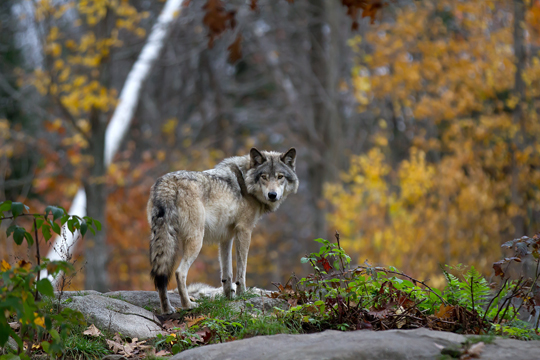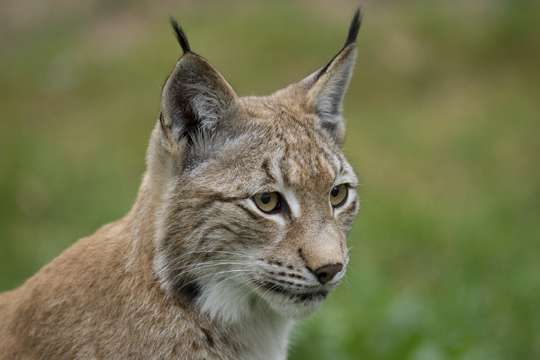The Cultural Baggage of Wild Animals
Freiburg, Sep 05, 2019
One, a ferocious beast from the fairy tales, the other an appealing pussycat: how wolves and lynxes are perceived by the German people differs wildly. However, neither predator is a danger to humans, says Dr. Marco Heurich. In his book “Wolf, Luchs und Bär in der Kulturlandschaft”, he describes the conflicts and approaches to dealing with these large carnivores. But despite wolves and lynxes being viewed very differently by people, both species are endangered by illegal hunting.
 Many people have a deep-seated fear of the wolf. Photo: Jim Cumming88/stock.adobe.com
Many people have a deep-seated fear of the wolf. Photo: Jim Cumming88/stock.adobe.com
The wolf is back in Germany – and a lot has been written about it in recent months: no longer just in fairy tales as an animal character, but in newspaper reports as a real culprit that rips apart farm animals. In some cases, popular anxiety has risen so much that the Federal cabinet has decided to change the German nature conservation act. This would make it easier to shoot a wolf and its pack. The aim is to better protect the citizens of regions where wolves are already coming nearer to residential areas, and to protect grazing animals, the government explains in its proposal.
Nature conservation biologist Dr. Marco Heurich takes a critical view of this. “We humans should learn to live with the wolf instead,” says the associate professor from the University of Freiburg. The wolf’s return to landscapes dominated by humans is a major challenge to the protection of this species: “The question of how people can coexist with predators gives rise to strong emotions. In fairy tales the wolf is presented as a ferocious beast. In addition, the animals live in packs and their howling is unearthly. For most people they represent a deep-seated fear. “
“Wolves don’t prey on humans”
The researcher studies the populations of large wild animals such as the lynx and of course wolves. To do this he uses processes such as telematics, photo-traps, computer simulation and genetic analysis. Heurich also draws on key figures from the federal documentation center, the DBBW: national monitoring of wolves includes both ‘hard facts’ – such as images from photo-traps, genetic data, cadavers and verified data such as pictures of bites and tracks – and unconfirmed observations. “The wolf population is rising steadily, by about 30 per cent a year,” he explains, “as until now they have been strictly protected. Nevertheless, people rarely encounter these animals. For instance, in the Bavarian Forest there is a pack, but visitors haven’t seen it yet.”
Heurich cannot rationalize the fear people in Germany have of wolves, “Wolves don’t prey on humans. Since the first documented litter in Germany in 2000, nobody has been harmed by a wolf. This is a major difference for example from tigers, which do actually see humans as prey. The dog is seen as man’s best friend, but the wolf is completely irrationally seen as something evil and dangerous.”
Problems begin with feeding
When young animals leave their parents and search for a territory of their own, they cover large distances, for example from the Bavarian Forest to Thüringia or in one case even as far as Hamburg. “Of course it can then happen that a wolf gets lost and is sighted in a village.” Young animals do not panic, Heurich says, when they encounter humans, “As a rule there is no danger from healthy wolves. But that doesn’t mean that can’t change at some time. The problems arise when the animals are fed.” Statistics from the national parks in North America show that if visitors offer wolves food, then after just a short time they start to beg aggressively for food.
Heurich thinks it is important that there is good wild animal management in all regions of Germany, so that observations can be reported and analyzed. If a wolf behaves unusually, the first attempt should be to drive it off. However, in the worst case, Heurich believes, the animal should be killed, “Human safety has priority.” But before culling is made easier, as soon as wolves attack farm animals, the researcher pleads for investments to be made in safety precautions – such as electric fences and sheep dogs which can keep predators away. “Small electric fences are very effective, and can keep wolves out of conflict-laden areas where there are higher densities of farm animals.”
 The lynx is even popular in regions where it is common.
The lynx is even popular in regions where it is common.
Photo: Ralph Frank/WWF
Conflicts intensify over the lynx
As well as wolves there are other large wild animals that hunt other animals in the German forests – for instance the lynx. Through targeted resettlements across Europe lynxes have started to expand across Germany too. “Unlike the wolf, the lynx has no cultural baggage,” explains the nature conservation biologist. “It doesn’t appear in fairy tales and the media report objectively about it. In most cases the newspapers present current research projects and their results, and therefore convey more wildlife knowledge of the lynx.” People are not afraid of the lynx. Surveys show, Heurich explains, that these animals are seen very sympathetically – even in regions where lynxes are common.
However, unlike wolves, the lynx population in certain areas of Germany is not growing. This is due to poaching. Heurich explains that modeling shows that up to fifteen animals a year fall victim to illegal activities in the Bohemian Forest ecosystem, the area along the Czech/German/Austrian border. Surveys of Czech hunters have shown that one motivation for this is to get rid of competition for the wild deer. “Lynxes are also easier to catch or kill than wolves, because they take longer eating their prey. Once they have killed a deer, they only leave it three or four days later.” So the probability of lynxes dying out has reached a critical point in the Bohemian Forest, “The probability of the lynx population becoming extinct again is at its worst around 74 per cent.”
Annette Kollefrath-Persch

